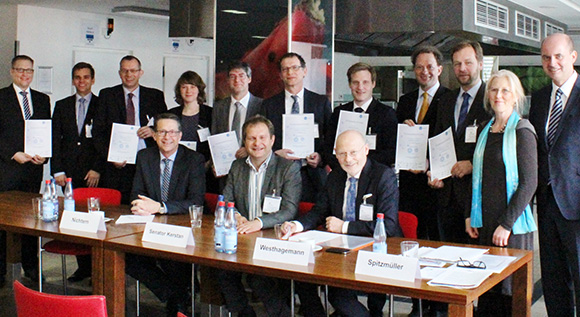Teaming up with others to save energy
Industrial companies are teaming up to make better use of energy. Setting up energy efficiency networks will make it easier for companies to meet the targets set by the Federal Government. Almost 60 networks have been created so far. By 2020, their number is to reach 500.
 Inauguration of the ‘energy efficiency network of Hamburg industry’ on 22 April 2016 © IVH Industrieverband Hamburg e.V.
Inauguration of the ‘energy efficiency network of Hamburg industry’ on 22 April 2016 © IVH Industrieverband Hamburg e.V.
In a steel mill located on the borders of the river Elbe, a long, red-hot steel bar is rolled continuously until it becomes as thin as a wire. Although this process requires a lot of energy, this does not mean that energy has to be wasted– at least, not in Hamburg. In future, the steel mill located on the borders of the river Elbe will be able to drastically reduce its energy consumption thanks to a new oven that can recover heat. This will help save 3,800 tonnes of carbon emissions per year and also considerably reduce the energy bill.
The steel mill is only one of more than 500 companies across Germany that has teamed up with other companies in their region or industry with the goal of saving energy. The mill is part of a network of thirteen companies from Hamburg that aims at reducing carbon emissions by a total of 60,000 tonnes by the end of 2018.
Since the beginning of 2015, around 60 ‘energy efficiency networks’ have been formed across Germany. By 2020, the number of these networks is to rise to 500. This is one of the goals set by the Federal Government and 21 business associations under the ‘Energy Efficiency Networks Initiative’.
Protecting the climate, strengthening competition
Every company within the network pursues its own strategy when it comes to saving energy. This is also true for the ‘energy efficiency network of Hamburg industry’: a waste management company is aiming to save 970 tonnes of carbon emissions by changing the process of cleaning the waste heat boiler from manual to automatic. A railway company is aiming to cut 250 tonnes of carbon emissions by using new hybrid locomotives. An oil refinery is aiming to cut 6,300 tonnes of carbon emissions by using heat more efficiently and relying on efficient processes and machinery.
Some 56 individual measures have been defined within the network, and every single one is helping to drive Germany’s energy transition forward.
Creating mutual benefits
An energy efficiency network consists of 8 to 15 companies. It may be initiated by the companies themselves, or by business associations, the chambers, utilities or municipalities.
The benefits of working together within a network have already become very clear. Companies can reduce their energy bill twice as fast as other companies in the same industry. This helps raise productivity and competitiveness and boosts the company’s reputation among customers and employees. One reason for this is that companies which are part of an energy efficiency network keep pace with the latest developments in energy efficiency. New ways of saving energy are emerging all the time, and new technologies help companies raise their energy efficiency.
Saving energy by working together
“Sharing experience and ideas encourages companies to save energy”, says Andreas Kuhlmann, Director of the German Energy Agency (dena). The German Energy Agency serves as the headquarters of the Energy Efficiency Networks Initiative – as a contact point for the companies and partners involved. “By engaging in dialogue with other companies within the network, companies obtain important information on how they can improve their energy efficiency. By making the right investment, companies can reduce their energy consumption by 10 to 30 per cent.”
Most of the companies involved in energy efficiency networks are still medium-sized an large manufacturing companies and utilities. Energy audits and energy management is something these companies are concerned with on a daily basis. By teaming up with others and working with experts within the network, they can better assess the results obtained during an energy audit and implement specific measures in order to save energy.
As a next step, smaller companies from the trade and crafts sector are also to be encouraged to join energy efficiency networks.
Support from the German Länder
More and more of the German Länder are promoting energy efficiency networks at state level. In Bavaria, for example, the Economic Affairs Ministry has initiated the Bavarian Energy Efficiency Network Initiative (‘BEEN-i’) which brings together key business and industrial associations. The goal of this initiative is to connect the various energy efficiency networks that exist throughout Bavaria – to promote networking between different networks. The authority responsible for energy efficiency in Baden-Württemberg is pursuing a similar goal. It aims at improving the representation of SMEs in business networks located across 12 different regions and helping them implement energy efficiency measures. The state of Lower Saxony has adopted guidelines on promoting the establishment of networks in which a focus is placed on small and medium-sized enterprises.
It all started with the National Action Plan on Energy Efficiency
The Energy Efficiency Networks Initiative was launched at the end of 2014. It is part of the Federal Government’s National Action Plan on Energy Efficiency (NAPE). NAPE is to help reduce Germany’s energy consumption by 20 per cent by 2020 relative to 2008 levels.

